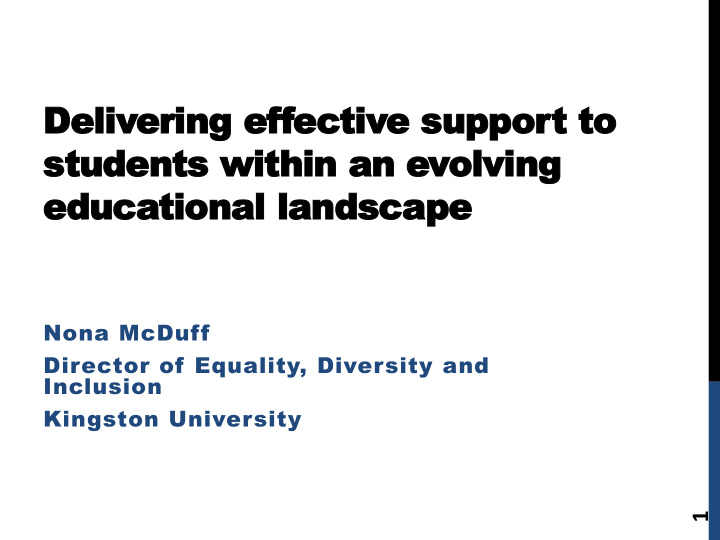



Delivering eff ffective support to students within an evolving educational landscape Nona McDuff Director of Equality, Diversity and Inclusion Kingston University 1
AIMS 1. The whole journey (starting with ‘the end’) 2. A few external changes that shape the journey • The Teaching Excellence Framework (TEF) and the Social Mobility Advisory Group • Changes to Disabled Students Allowance • SEND reforms 3. The implications for practice – opportunities and challenges 2
THE END GOAL (?) - EMPLOYMENT 3
GETTING A DEGREE With the exception of business and administrative studies and combined studies, in every subject area a higher proportion of non- disabled qualifiers received a first/2:1 than disabled qualifiers. The disability degree attainment gap was widest in medicine and dentistry (7.2 percentage points), followed by mathematical sciences (5.7 percentage points) and physical sciences Undergraduate = 11.4%, Research postgraduate = 6.7% Taught postgraduate = 6.3% (ECU, 2015) 4
Getting into university Increase over 10 years Most common disclosed impairments in 2013/14 were LD = 48% and mental health = 12.8% Students with disabilities and learning differences are less likely to stay in HE 5
THE TEF The Government has introduced the TEF as a way of: • Better informing students’ choices about what and where to study • Raising esteem for teaching • Recognising and rewarding excellent teaching • Better meeting the needs of employers, business, industry and the professions Demonstrate meet QAA standards and have an Access and Participation Statement Based upon 3 year core metrics and split metrics - including disability plus an illuminating narrative The better HEIs do the higher fees they can charge 6
TEF metrics aligned with aspects of quality Aspect Metric Source Teaching Quality Teaching on my course NSS Q1-4 Teaching Quality Assessment and feedback NSS Q5-9 Learning Environment Academic support NSS Q10-12 Learning Environment Non-Continuation HESA and ILR data Student Outcomes and Employment or further study DLHE declared activity 6 months after Learning Gain graduation Student Outcomes and Highly skilled employment or further study DLHE declared activity 6 months after Learning Gain graduation 7
TEF ‘Medals’ • Gold - A provider with three or more positive flags and no negative flags should be considered initially as Gold. • Bronze - A provider with two or more negative flags should be considered initially as Bronze, regardless of the number of positive flags. • Silver - all other providers, including those with no flags at all, should be considered initially as Silver. 8
SOCIAL MOBILITY ADVISORY GROUP Better sharing of data between schools, colleges, universities and educational charities Focus on increasing graduate outcomes, employment rates, and particularly long-term professional employment rates (mental health condition). Disability Sector Leadership Group to support delivery of inclusive practice and the move towards a social model of disability. 9
CHANGES TO DISABLED STUDENT’S ALLOWANCE MEAN HEIS ARE: Required to develop an inclusive teaching and learning strategy Expected to consider how they deliver information to students and whether strategies can be put in place to encourage greater independence and autonomy for students with disabilities and learning differences 10
OVERVIEW OF THE REFORMS: CHILDREN AND FAMILIES ACT Where Enabler s Children, young disagreements people and parents Joint commissioning happen, they can understand a joined up be resolved early system, designed Local offer Better Outcomes and amicably, with around their needs. disagreement the option of a Having friends resolution processes Tribunal for those Employment Positive that need it. prospects Wellbeing 0-25 Information, Children and advice and young people with support SEND and families Good Making their qualifications views heard Option of a Personal Integrated assessment and Extending choice and Budget planning Education Health and control over their Care plan is holistic, support . co-produced and focused on outcomes.
Developing inclusive environments An inclusive approach : “Necessitates…equity considerations being embedded within all functions of the institution and treated as an ongoing process of quality enhancement. Making a shift of such magnitude requires cultural and systemic change at both the policy and practice levels.” (Wray, 2013: 4) 12
ALL CHANGE - OPPORTUNITIES AND CHALLENGES Acting earlier where More holistic in our we can to prevent approach to the whole things getting worse lifecycle 0-employment Using outcome- Collaboration and focused planning to connectivity get the best result Being child, young for children and person, and family young people centred Focusing on family Building trust resilience and strengths Winning hearts and minds 13
Recommend
More recommend